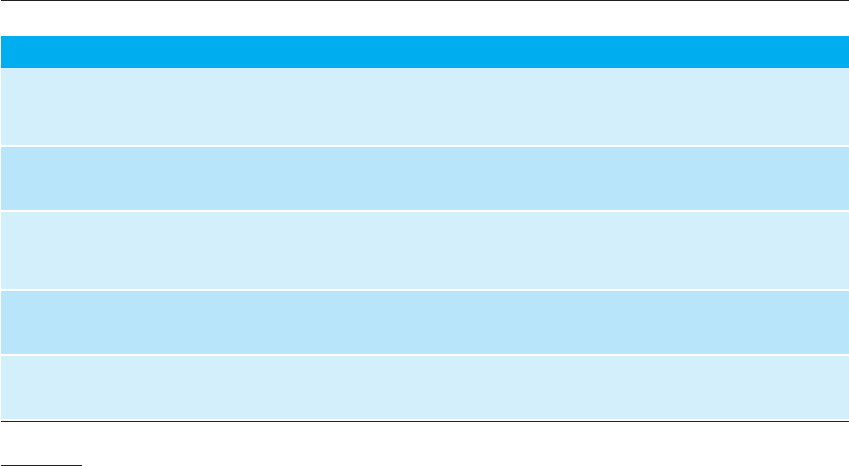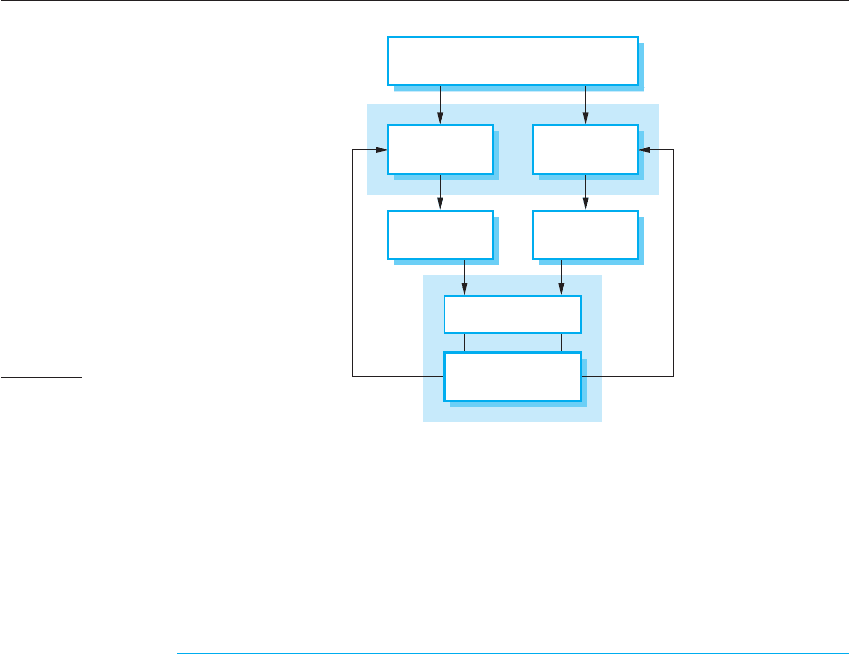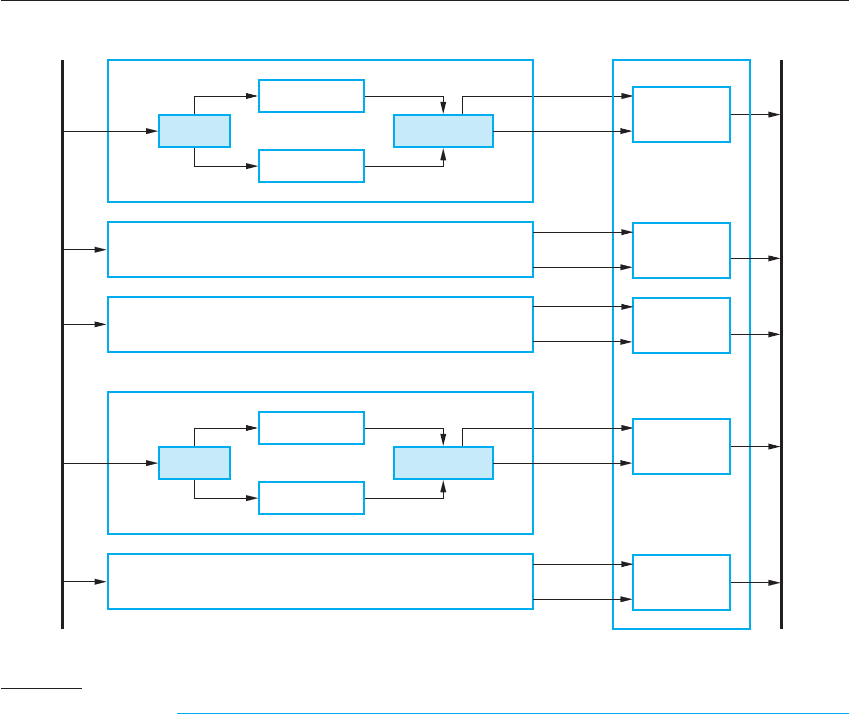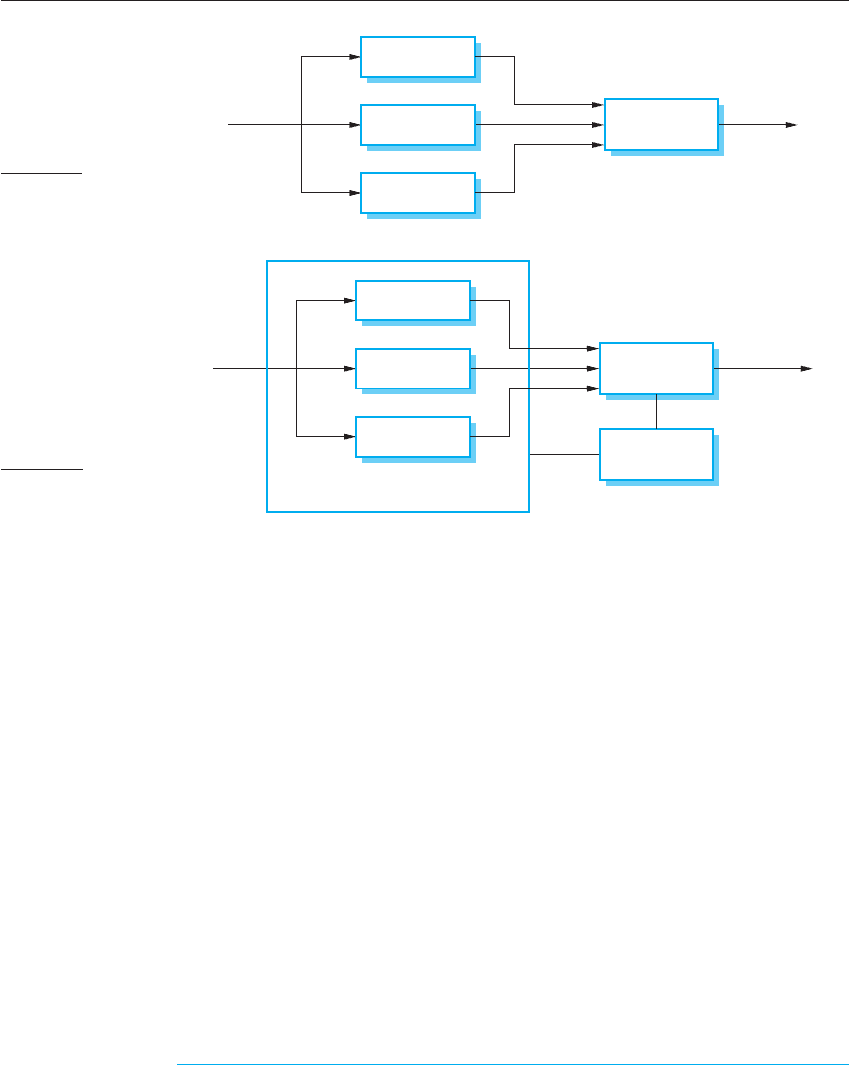Sommerville I. Software Engineering (9th edition)
Подождите немного. Документ загружается.


344 Chapter 13 ■ Dependability engineering
The Ariane 5 explosion
In 1996, the European Space Agency’s Ariane 5 rocket exploded 37 seconds after liftoff on its maiden flight. The fault
was caused by a software systems failure. There was a backup system but this was not diverse and so the software
in the backup computer failed in exactly the same way. The rocket and its satellite payload were destroyed.
http://www.SoftwareEngineering-9.com/Web/DependabilityEng/Ariane/
components of the system are of different types, thus increasing the chances that
they will not fail in exactly the same way.
We use redundancy and diversity to enhance dependability in our everyday lives.
As an example of redundancy, most people keep spare light bulbs in their homes so
that they can quickly recover from the failure of a light bulb that is in use.
Commonly, to secure our homes we use more than one lock (redundancy) and, usu-
ally, the locks used are of different types (diversity). This means that if an intruder
finds a way to defeat one of the locks, they have to find a different way of defeating
the other lock before they can gain entry. As a matter of routine, we should all back
up our computers and so maintain redundant copies of our data. To avoid problems
with disk failure, backups should be kept on a separate, diverse, external device.
Software systems that are designed for dependability may include redundant com-
ponents that provide the same functionality as other system components. These are
switched into the system if the primary component fails. If these redundant compo-
nents are diverse (i.e., not the same as other components), a common fault in replicated
components will not result in a system failure. Redundancy may also be provided by
including additional checking code, which is not strictly necessary for the system to
function. This code can detect some kinds of faults before they cause failures. It can
invoke recovery mechanisms to ensure that the system continues to operate.
In systems for which availability is a critical requirement, redundant servers are
normally used. These automatically come into operation if a designated server fails.
Sometimes, to ensure that attacks on the system cannot exploit a common vulnera-
bility, these servers may be of different types and may run different operating sys-
tems. Using different operating systems is one example of software diversity and
redundancy, where comparable functionality is provided in different ways. I discuss
software diversity in more detail in Section 13.3.4.
Diversity and redundancy may also be also used to achieve dependable processes
by ensuring that process activities, such as software validation, do not rely on a sin-
gle process or method. This improves software dependability because it reduces the
chances of process failure, where human errors made during the software develop-
ment process lead to software errors. For example, validation activities may include
program testing, manual program inspections, and static analysis as fault-finding
techniques. These are complementary techniques in that any one technique might
find faults that are missed by the other methods. Furthermore, different team mem-
bers may be responsible for the same process activity (e.g., a program inspection).

13.2 ■ Dependable processes 345
People tackle tasks in different ways depending on their personality, experience, and
education, so this kind of redundancy provides a diverse perspective on the system.
As I discuss in Section 13.3.4, achieving software diversity is not straightforward.
Diversity and redundancy make systems more complex and usually harder to under-
stand. Not only is there more code to write and check, additional functionality must also
be added to the system to detect component failure and to switch control to alternative
components. This additional complexity means that it is more likely that programmers
will make errors and less likely that people checking the system will find these errors.
As a consequence, some people think that it is best to avoid software redundancy
and diversity. Their view is that the best approach is to design the software to be as sim-
ple as possible, with extremely rigorous software verification and validation proce-
dures (Parnas et al., 1990). More can be spent on verification and validation because of
the savings that result from not having to develop redundant software components.
Both approaches are used in commercial, safety-critical systems. For example,
the Airbus 340 flight control hardware and software is both diverse and redundant
(Storey, 1996). The flight control software on the Boeing 777 is based on a redun-
dant hardware but each computer runs the same software, which has been exten-
sively validated. The Boeing 777 flight control system designers have focused on
simplicity rather than redundancy. Both of these aircraft are very reliable, so both the
diverse and the simple approach to dependability can clearly be successful.
13.2 Dependable processes
Dependable software processes are software processes that are designed to produce
dependable software. A company using a dependable process can be sure that the
process has been properly enacted and documented and that appropriate development
techniques have been used for critical systems development. The rationale for invest-
ing in dependable processes is that a good software process is likely to lead to deliv-
ered software that contains fewer errors and is therefore less likely to fail in execution.
Figure 13.2 shows some of the attributes of dependable software processes.
The evidence that a dependable process has been used is often important in con-
vincing a regulator that the most effective software engineering practice has been
applied in developing the software. System developers will normally present a
model of the process to a regulator, along with evidence that the process has been
Dependable operational processes
This chapter discusses dependable development processes but an equally important contributor to system
dependability is a system’s operational processes. In designing these operational processes, you have to take
into account human factors and always bear in mind that people are liable to make mistakes when using a
system. A dependable process should be designed to avoid human errors and, when mistakes are made, the
software should detect the mistakes and allow them to be corrected.
http://www.SoftwareEngineering-9.com/Web/DependabilityEng/HumanFactors/

346 Chapter 13 ■ Dependability engineering
Figure 13.2
Attributes of
dependable
processes
Process Characteristic Description
Documentable The process should have a defined process model that sets out the activities
in the process and the documentation that is to be produced during these
activities.
Standardized A comprehensive set of software development standards covering software
production and documentation should be available.
Auditable The process should be understandable by people apart from process participants,
who can check that process standards are being followed and make suggestions
for process improvement.
Diverse The process should include redundant and diverse verification and validation
activities.
Robust The process should be able to recover from failures of individual process
activities.
followed. The regulator also has to be convinced that the process is used consistently
by all of the process participants and that it can be used in different development
projects. This means that the process must be explicitly defined and repeatable:
1. An explicitly defined process is one that has a defined process model that is used
to drive the software production process. There must be data collected during
the process that demonstrates that all of the necessary steps in the process model
have been enacted.
2. A repeatable process is one that does not rely on individual interpretation and
judgment. Rather, the process can be repeated across projects and with different
team members, irrespective of who is involved in the development. This is par-
ticularly important for critical systems, which often have a long development
cycle during which there are often significant changes in the development team.
Dependable processes make use of redundancy and diversity to achieve reliabil-
ity. They often include different activities that have the same aim. For example, pro-
gram inspections and testing aim to discover errors in a program. The approaches are
complementary so that together they are likely to discover a higher proportion of
errors than would be found using one technique on its own.
The activities that are used in dependable processes obviously depend on the type
of software that is being developed. In general, however, these activities should be
geared to avoiding the introduction of errors into a system, detecting and removing
errors, and maintaining information about the process itself. Examples of activities
that might be included in a dependable process include:
1. Requirements reviews to check that the requirements are, as far as possible,
complete and consistent.

13.2 ■ Dependable processes 347
2. Requirements management to ensure that changes to the requirements are con-
trolled and that the impact of proposed requirements changes is understood by
all developers affected by the change.
3. Formal specification, where a mathematical model of the software is created
and analyzed. I discussed the benefits of formal specification in Chapter 12.
Perhaps its most important benefit is that it forces a very detailed analysis of the
system requirements. This analysis itself is likely to discover requirements
problems that may have been missed in requirements reviews.
4. System modeling, where the software design is explicitly documented as a set of
graphical models, and the links between the requirements and these models are
explicitly documented.
5. Design and program inspections, where the different descriptions of the system
are inspected and checked by different people. Inspections are often driven by
checklists of common design and programming errors.
6. Static analysis, where automated checks are carried out on the source code of
the program. These look for anomalies that could indicate programming errors
or omissions. I discuss static analysis in Chapter 15.
7. Test planning and management, where a comprehensive set of system tests is
designed. The testing process has to be carefully managed to demonstrate that
these tests provide coverage of the system requirements and have been correctly
applied in the testing process.
As well as process activities that focus on system development and testing, there
must also be well-defined quality management and change management processes.
Although the specific activities in a dependable process may vary from one company
to another, the need for effective quality and change management is universal.
Quality management processes (discussed in Chapter 24) establish a set of process
and product standards. They also include activities that capture process information
to demonstrate that these standards have been followed. For example, there may be a
standard defined for carrying out program inspections. The inspection team leader is
responsible for documenting the process to show that the inspection standard has
been followed.
The safety life cycle
The International Electrotechnical Commission has devised a process standard (IEC 61508) for protection
systems engineering. This is based around the notion of a safety life cycle, which makes a clear distinction
between safety engineering and system engineering. The first stages of the IEC 61508 safety life cycle define the
scope of the system, assess the potential system hazards, and estimate the risks they pose. This is followed by
the specification of the safety requirements and the allocation of these safety requirements to different
subsystems. The idea is to limit the extent of safety-critical functionality to allow specific techniques for critical
systems engineering to be applied to the development of the safety-critical system.
http://www.SoftwareEngineering-9.com/Web/SafetyLifeCycle/

348 Chapter 13 ■ Dependability engineering
Change management, discussed in Chapter 25, is concerned with managing
changes to a system, ensuring that accepted changes are actually implemented and
confirming that planned releases of the software include the planned changes. One
common problem with software is that the wrong components are included in a system
build. This can lead to a situation where an executing system includes components that
have not been checked during the development process. Configuration management
procedures must be defined as part of the change management process to ensure that
this does not happen.
There is a widely held view that agile approaches, as discussed in Chapter 3, are
not really suitable for dependable processes (Boehm, 2002). Agile approaches focus
on developing the software rather than on documenting what has been done. They
often have a fairly informal approach to change and quality management. Plan-based
approaches to dependable systems development, which create documentation that
regulators and other external system stakeholders can understand, are generally pre-
ferred. Nevertheless, the benefits of agile approaches are equally applicable to criti-
cal systems. There have been reports of successes in applying agile methods in this
area (Lindvall, et al., 2004) and it is likely that variants of agile methods that are suit-
able for critical systems engineering will be developed.
13.3 Dependable system architectures
As I have discussed, dependable systems development should be based around a
dependable process. However, although you probably need a dependable process to
create dependable systems, this is not enough in itself to ensure dependability. You
also need to design a system architecture for dependability, especially when fault tol-
erance is required. This means that the architecture has to be designed to include
redundant components and mechanisms that allow control to be switched from one
component to another.
Examples of systems that may need fault-tolerant architectures are systems in air-
craft that must be in operation throughout the duration of the flight, telecommunica-
tion systems, and critical command and control systems. Pullum (2001) describes
different types of fault-tolerant architecture that have been proposed and Torres-
Pomales surveys software fault-tolerance techniques (2000).
The simplest realization of a dependable architecture is in replicated servers, where
two or more servers carry out the same task. Requests for processing are channeled
through a server management component that routes each request to a particular server.
This component also keeps track of server responses. In the event of server failure,
which is usually detected by a lack of response, the faulty server is switched out of the
system. Unprocessed requests are resubmitted to other servers for processing.
This replicated server approach is widely used for transaction processing systems
where it is easy to maintain copies of transactions to be processed. Transaction
processing systems are designed so that data is only updated once a transaction has
finished correctly so delays in processing do not affect the integrity of the system.

13.3 ■ Dependable system architectures 349
It can be an efficient way of using hardware if the backup server is one that is nor-
mally used for low-priority tasks. If a problem occurs with a primary server, its pro-
cessing is transferred to the backup server, which gives that work the highest priority.
Replicated servers provide redundancy but not usually diversity. The hardware is
usually identical and they run the same version of the software. Therefore, they can
cope with hardware failures and software failures that are localized to a single
machine. They cannot cope with software design problems that cause all versions of
the software to fail at the same time. To handle software design failures, a system has
to include diverse software and hardware, as I have discussed in Section 13.1.
Software diversity and redundancy can be implemented in a number of different
architectural styles. I describe some of these in the remainder of this section.
13.3.1 Protection systems
A protection system is a specialized system that is associated with some other sys-
tem. This is usually a control system for some process, such as a chemical manufac-
turing process or an equipment control system, such as the system on a driverless
train. An example of a protection system might be a system on a train that detects if
the train has gone through a red signal. If so, and there is no indication that the train
control system is decelerating the train, then the protection system automatically
applies the train brakes to bring it to a halt. Protection systems independently moni-
tor their environment and, if the sensors indicate a problem that the controlled sys-
tem is not dealing with, then the protection system is activated to shut down the
process or equipment.
Figure 13.3 illustrates the relationship between a protection system and a con-
trolled system. The protection system monitors both the controlled equipment and
the environment. If a problem is detected, it issues commands to the actuators to shut
down the system or invoke other protection mechanisms such as opening a pressure-
release valve. Notice that there are two sets of sensors. One set is used for normal
system monitoring and the other specifically for the protection system. In the event
of sensor failure, there are backups that will allow the protection system to continue
in operation. There may also be redundant actuators in the system.
A protection system only includes the critical functionality that is required to
move the system from a potentially unsafe state to a safe state (system shutdown). It
is an instance of a more general fault-tolerant architecture in which a principal sys-
tem is supported by a smaller and simpler backup system that only includes essential
functionality. For example, the U.S. space shuttle control software has a backup sys-
tem that includes ‘get you home’ functionality; that is, the backup system can land
the vehicle if the principal control system fails.
The advantage of this kind of architecture is that protection system software can be
much simpler than the software that is controlling the protected process. The only
function of the protection system is to monitor operation and to ensure that the system
is brought to a safe state in the event of an emergency. Therefore, it is possible to invest
more effort in fault avoidance and fault detection. You can check that the software

350 Chapter 13 ■ Dependability engineering
specification is correct and consistent and that the software is correct with respect to its
specification. The aim is to ensure that the reliability of the protection system is such
that it has a very low probability of failure on demand (say, 0.001). Given that demands
on the protection system should be rare, a probability of failure on demand of 1/1,000
means that protection system failures should be very rare indeed.
13.3.2 Self-monitoring architectures
A self-monitoring architecture is a system architecture in which the system is
designed to monitor its own operation and to take some action if a problem is
detected. This is achieved by carrying out computations on separate channels and
comparing the outputs of these computations. If the outputs are identical and are
available at the same time, then it is judged that the system is operating correctly. If
the outputs are different, then a failure is assumed. When this occurs, the system will
normally raise a failure exception on the status output line, which will lead to control
being transferred to another system. This is illustrated in Figure 13.4.
To be effective in detecting both hardware and software faults, self-monitoring
systems have to be designed so that:
1. The hardware used in each channel is diverse. In practice, this might mean that
each channel uses a different processor type to carry out the required computa-
tions, or the chipset making up the system may be sourced from different manu-
facturers. This reduces the probability of common processor design faults
affecting the computation.
2. The software used in each channel is diverse. Otherwise, the same software
error could arise at the same time on each channel. I discuss the difficulties of
achieving truly diverse software in Section 13.3.4.
Actuators
Controlled
Equipment
System Environment
Control
System
Protection
System
Protection
Sensors
Sensors
Figure 13.3 Protection
system architecture

13.3 ■ Dependable system architectures 351
On its own, this architecture may be used in situations where it is important for
computations to be correct, but where availability is not essential. If the answers
from each channel differ, the system simply shuts down. For many medical treatment
and diagnostic systems, reliability is more important than availability as an incorrect
system response could lead to the patient receiving incorrect treatment. However, if
the system simply shuts down in the event of an error, this is an inconvenience but
the patient will not usually be harmed by the system.
In situations where high availability is required, you have to use several self-
checking systems in parallel. You need a switching unit that detects faults and selects
a result from one of the systems, where both channels are producing a consistent
response. Such an approach is used in the flight control system for the Airbus 340
series of aircraft, in which five self-checking computers are used. Figure 13.5 is a
simplified diagram illustrating this organization.
In the Airbus flight control system, each of the flight control computers carry out
the computations in parallel, using the same inputs. The outputs are connected to
hardware filters that detect if the status indicates a fault and, if so, that the output from
that computer is switched off. The output is then taken from an alternative system.
Therefore, it is possible for four computers to fail and for the aircraft operation to con-
tinue. In more than 15 years of operation, there have been no reports of situations
where control of the aircraft has been lost due to total flight control system failure.
The designers of the Airbus system have tried to achieve diversity in a number of
different ways:
1. The primary flight control computers use a different processor from the second-
ary flight control systems.
2. The chipset that is used in each channel in the primary and secondary systems is
supplied by a different manufacturer.
3. The software in the secondary flight control systems provides critical function-
ality only—it is less complex than the primary software.
4. The software for each channel in both the primary and the secondary systems is
developed using different programming languages and by different teams.
5. Different programming languages are used in the secondary and primary systems.
As I discuss in the following section, these do not guarantee diversity but they
reduce the probability of common failures in different channels.
Channel 1
Channel 2
Splitter Comparator
Input Value
Output Value
Status
Figure 13.4 Self-
monitoring architecture

352 Chapter 13 ■ Dependability engineering
13.3.3 N-version programming
Self-monitoring architectures are examples of systems in which multiversion pro-
gramming is used to provide software redundancy and diversity. This notion of mul-
tiversion programming has been derived from hardware systems where the notion of
triple modular redundancy (TMR) has been used for many years to build systems
that are tolerant of hardware failures (Figure 13.6).
In a TMR system, the hardware unit is replicated three (or sometimes more)
times. The output from each unit is passed to an output comparator that is usually
implemented as a voting system. This system compares all of its inputs and, if two or
more are the same, then that value is output. If one of the units fails and does not pro-
duce the same output as the other units, its output is ignored. A fault manager may
try to repair the faulty unit automatically but if this is impossible, the system is auto-
matically reconfigured to take the unit out of service. The system then continues to
function with two working units.
This approach to fault tolerance relies on most hardware failures being the result
of component failure rather than design faults. The components are therefore likely
to fail independently. It assumes that, when fully operational, all hardware units per-
form to specification. There is therefore a low probability of simultaneous compo-
nent failure in all hardware units.
Channel 1
Channel 2
Splitter Comparator
Output
Status
Primary Flight Control System 1
Secondary Flight Control System 1
Primary Flight Control System 2
Primary Flight Control System 3
Input
Filter
Output
Output
Status
Filter
Output
Status
Filter
Secondary Flight Control System 2
Output
Status
Filter
Channel 1
Channel 2
Splitter Comparator
Output
Status
Filter
Figure 13.5
Airbus flight
control
system
architecture

13.3 ■ Dependable system architectures 353
Of course, the components could all have a common design fault and thus all pro-
duce the same (wrong) answer. Using hardware units that have a common specifica-
tion but which are designed and built by different manufacturers reduces the chances
of such a common mode failure. It is assumed that the probability of different teams
making the same design or manufacturing error is small.
A similar approach can be used for fault-tolerant software where N diverse ver-
sions of a software system execute in parallel (Avizienis, 1985; Avizienis,1995).
This approach to software fault tolerance, illustrated in Figure 13.7, has been used in
railway signaling systems, aircraft systems, and reactor protection systems.
Using a common specification, the same software system is implemented by a
number of teams. These versions are executed on separate computers. Their outputs
are compared using a voting system, and inconsistent outputs or outputs that are not
produced in time are rejected. At least three versions of the system should be avail-
able so that two versions should be consistent in the event of a single failure.
N-version programming may be less expensive that self-checking architectures in sys-
tems for which a high level of availability is required. However, it still requires several
different teams to develop different versions of the software. This leads to very high soft-
ware development costs. As a result, this approach is only used in systems where it is
impractical to provide a protection system that can guard against safety-critical failures.
13.3.4 Software diversity
All of the above fault-tolerant architectures rely on software diversity to achieve fault
tolerance. This is based on the assumption that diverse implementations of the same
specification (or a part of the specification, for protection systems) are independent.
They should not include common errors and so will not fail in the same way, at the
A1
A2
A3
Output
Selector
Input
Figure 13.6 Triple
modular redundancy
Version 1
Version 2
Version 3
Output
Selector
N Software Versions
Agreed
Result
Fault
Manager
Input
Figure 13.7 N-version
programming
